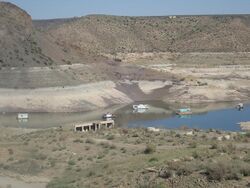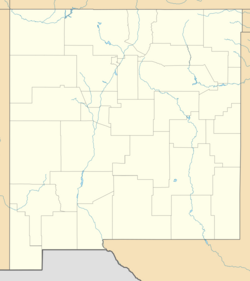Earth:McRae Formation
| McRae Formation Stratigraphic range: Maastrichtian (Lancian) ~70–66 Ma | |
|---|---|
 McRae Formation near its type location, Elephant Butte Reservoir, New Mexico, USA. The light bands are "bathtub rings" from stands of the reservoir. | |
| Type | Geological formation |
| Sub-units | Hall Lake & Jose Creek Members |
| Underlies | Love Ranch Formation |
| Overlies | Mesaverde Group |
| Thickness | 3,000 ft (910 m) |
| Lithology | |
| Primary | Sandstone, shale, conglomerate |
| Other | Tuff |
| Location | |
| Coordinates | [ ⚑ ] : 33°11′49″N 107°10′01″W / 33.197°N 107.167°W |
| Paleocoordinates | [ ⚑ ] 40°24′N 85°42′W / 40.4°N 85.7°W |
| Region | New Mexico |
| Country | |
| Type section | |
| Named for | Fort McRae |
| Named by | Kelley & Silver |
| Year defined | 1952 |
The McRae Formation is a geological formation exposed in southern New Mexico whose strata date back to the Late Cretaceous.[1] Dinosaur remains are among the fossils that have been recovered from the formation.[2][3][4][5]
Description
The formation consists of a basal conglomerate interbedded with shale and siltstone and a sequence of alternating sandstone and shale. The lower conglomerates contain volcanic debris, while the upper beds contain sparse nonvolcanic rock fragments. The shales are reddish brown to purplish while the sandstones are light gray. The sandstones are medium bedded to massive and sometimes form hogbacks. The total thickness is in excess of 3,000 feet (910 m). The formation is present around Elephant Butte Reservoir, in the Caballo Mountains, and under much of the Jornada del Muerto. It overlies the Mesaverde Group, from which it derives much of its sediments.[1] It is overlain by the Love Ranch Formation.[6]
The formation is divided into the lower Jose Creek Member and the upper Hall Lake Member. The Jose Creek member is interpreted as mudflow or alluvial fan deposits emplaced in a humid tropical to semitropical environment. It includes distinctive breccia conglomerate beds.[7][8]
Fossil evidence firmly establishes that most of the McRae Formation is late Cretaceous in age. However, it is possible that some of the uppermost beds extend into the Paleocene.[9]
Fossil content
The formation contains a floral assemblage that includes Geinitzia cf. formosa, Canna magnifolia, Phyllites cf. ratonensis, Salix, Cinnamomum, Sabalites montana, Araucarites longifolia, Ficus planicostata, and Sequoia.[8][10][11]
Vertebrate paleofauna
W.T. Lee found a ceratopsian skeleton in the area in 1905. Additional vertebrate fossil fragments have been found at twelve locations, generally along the contact between the Jose Creek and Hall Lake members, that include ceratopsian frill and jaw fragments, ankylosaur armor fragments, a sauropod femur, and an incomplete jaw of Tyrannosaurus rex (found by a yachtsman in 1983.)[9][8] Turtle fossils have also been unearthed here.[12]
History of investigation
The formation was first named by V.C. Kelley and Caswell Silver in 1952 for Fort McRae. They designated the type location as the base of Elephant Butte and the eastern shore of Elephant Butte Reservoir.[1] H.P. Bushnell divided the formation into members in 1955.[7]
Kenneth Segerstrom and his coinvestigators argued in 1979 that the beds of the Cub Mountain Formation properly belong to the McRae Formation.[18] Spencer G. Lucas and his coinvestigators disagreed on the basis of fossil evidence, placing the former formation in the Eocene.[19]
In 2019, Lucas and his coinvestigators proposed promoting the McRae Formation to group rank and adding the Double Canyon Formation as its uppermost member. The Double Canyon Formation is over 425 meters (1,394 ft) of mudstone with some sandstone and conglomerate found between Elaphant Butte Reservoir and the Fra Cristobal Mountains to the northeast.[20]
See also
- List of dinosaur-bearing rock formations
- Kirtland Formation
References
- ↑ 1.0 1.1 1.2 Kelley & Silver 1952.
- ↑ Weishampel, Dodson & Osmólska 2004, pp. 574-588.
- ↑ Lozinsky, Richard; Hunt, Adrian; Wolberg, Donald; Lucas, Spencer. "Late Cretaceous (Lancian) dinosaurs from the McRae Formation, Sierra County, New Mexico". New Mexico Geology 6: 72–77. https://www.researchgate.net/publication/267818177.
- ↑ Wolberg, Donald; Lozinsky, Richard; Hunt, Adrian (1986). "Late Cretaceous (Maastrichtian-Lancian) vertebrate paleontology of the McRae Formation, Elephant Butte area, Sierra County, New Mexico". New Mexico Geological Society 37: 227–234. https://nmgs.nmt.edu/publications/guidebooks/downloads/37/37_p0227_p0234.pdf.
- ↑ Buck, Brenda J.; Mack, Greg H. (October 1995). "Latest Cretaceous (Maastrichtian) aridity indicated by paleosols in the McRae Formation, south-central New Mexico". Cretaceous Research 16 (5): 559–572. doi:10.1006/cres.1995.1036. ISSN 0195-6671. Bibcode: 1995CrRes..16..559B. http://dx.doi.org/10.1006/cres.1995.1036.
- ↑ Seager 2004, p. 192.
- ↑ 7.0 7.1 Bushnell 1955.
- ↑ 8.0 8.1 8.2 Lozinsky 1986.
- ↑ 9.0 9.1 Lozinsky et al. 1984.
- ↑ Estrada-Ruiz, Emilio; Upchurch, Garland R.; Wheeler, Elisabeth A.; Mack, Greg H. (May 2012). "Late Cretaceous Angiosperm Woods from the Crevasse Canyon and McRae Formations, South-Central New Mexico, USA: Part 1". International Journal of Plant Sciences 173 (4): 412–428. doi:10.1086/664714. ISSN 1058-5893. http://dx.doi.org/10.1086/664714.
- ↑ Estrada-Ruiz, Emilio; Wheeler, Elisabeth A.; Upchurch, Garland R.; Mack, Greg H. (February 2018). "Late Cretaceous Angiosperm Woods from the McRae Formation, South-Central New Mexico, USA: Part 2". International Journal of Plant Sciences 179 (2): 136–150. doi:10.1086/695503. ISSN 1058-5893. http://dx.doi.org/10.1086/695503.
- ↑ Lichtig, Asher; Lucas, Spencer (2015). "Cretaceous Turtles of New Mexico". Fossil Record 4 (67): 129–138. https://books.google.com/books?id=au2oDQAAQBAJ.
- ↑ 13.0 13.1 13.2 Lozinsky et al. 1984, pp. 73-77.
- ↑ Gillette, David; Wolberg, David; Hunt, Adrian (1986). "Tyrannosaurus rex from the McRae Formation (Lancian, Upper Cretaceous), Elephant Butte reservoir, Sierra County, New Mexico". New Mexico Geological Society 37th Annual Fall Field Conference Guidebook: 235–238. https://nmgs.nmt.edu/publications/guidebooks/downloads/37/37_p0235_p0238.pdf.
- ↑ Lucas, Mack & Estep 1998, pp. 223–227.
- ↑ Hunt, Rebecca K.; Lehman, Thomas M. (November 2008). "Attributes of the ceratopsian dinosaur Torosaurus, and new material from the Javelina Formation (Maastrichtian) of Texas". Journal of Paleontology 82 (6): 1127–1138. doi:10.1017/s0022336000055335. ISSN 0022-3360. http://dx.doi.org/10.1017/s0022336000055335.
- ↑ Williamson, Thomas E.; Weil, Anne (2008-12-12). "Stratigraphic distribution of sauropods in the Upper Cretaceous of the San Juan Basin, New Mexico, with comments on North America's Cretaceous 'sauropod hiatus'". Journal of Vertebrate Paleontology 28 (4): 1218–1223. doi:10.1671/0272-4634-28.4.1218. ISSN 0272-4634. Bibcode: 2008JVPal..28.1218W. http://dx.doi.org/10.1671/0272-4634-28.4.1218.
- ↑ Segerstrom, Stotelmeyer & Williams 1979.
- ↑ Lucas et al. 1989.
- ↑ Lucas et al. 2019.
Bibliography
- Bushnell, H.P. (1955). "Stratigraphy of the McRae formation, Sierra County, New Mexico". The Compass, Sigma Gamma Epsilon Journal of Earth Sciences 33 (1): 9–17.
- Kelley, V.C.; Silver, Caswell (1952). "Geology of the Caballo Mountains; with special reference to regional stratigraphy and structure and to mineral resources, including oil and gas". University of New Mexico Publications in Geology 4.
- Lozinsky, R.P. (1986). "Geologic and late Cenozoic history of the Elephant Butte area, Sierra County, New Mexico". New Mexico Bureau of Mines and Mineral Resources Circular 187. https://geoinfo.nmt.edu/publications/monographs/circulars/downloads/187/Circular-187.pdf. Retrieved 15 September 2020.
- Lozinsky, Richard P.; Hunt, Adrian P.; Woldberg, Donald L.; Lucas, Spencer G. (November 1984). "Late Cretaceous (Lancian) dinosaurs from the McRae Formation, Sierra County, New Mexico". New Mexico Geology: 72–77. https://www.researchgate.net/publication/267818177. Retrieved 15 September 2020.
- Lucas, S.G.; Cather, S.M.; Sealey, Paul; Hutchison, H.C. (1989). "Stratigraphy, paleontology, and depositional systems of the Eocene Cub Mountain Formation, Lincoln County, New Mexico; a preliminary report". New Mexico Geology 11 (1): 11–17. https://geoinfo.nmt.edu/publications/periodicals/nmg/11/n1/nmg_v11_n1_p11.pdf. Retrieved 2 August 2020.
- Lucas, Spencer G.; Mack, Greg H.; Estep, John W. (1998). "The Ceratopsian dinosaur Torosaurus from the Upper Cretaceous McRae Formation, Sierra County, New Mexico". Las Cruces Country II, New Mexico Geological Society, 49th Annual Field Conference Guidebook: 223–227. https://nmgs.nmt.edu/publications/guidebooks/downloads/49/49_p0223_p0227.pdf. Retrieved 24 October 2020.
- Lucas, Spencer G.; Nelson, W. John; Krainer, Karl; Elrick, Scott D. (2019). "The Cretaceous System in central Sierra County, New Mexico". New Mexico Geology 41 (1): 3–39. https://geoinfo.nmt.edu/publications/periodicals/nmg/41/n1/nmg_v41_n1.pdf. Retrieved 3 November 2020.
- Seager, William (2004). "Laramide (late Cretaceous-Eocene) tectonics of southwestern New Mexico". in Mack, G.H.; Giles, K.A.. The geology of New Mexico. A geologic history: New Mexico Geological Society Special Volume 11. pp. 249–270. ISBN 9781585460106.
- Segerstrom, Kenneth; Stotelmeyer, R.B.; Williams, F.E. (1979). "Mineral resources of the White Mountain Wilderness and adjacent areas, Lincoln County, New Mexico". U.S. Geological Survey Bulletin (1453). https://ngmdb.usgs.gov/Prodesc/proddesc_21553.htm. Retrieved 2 August 2020.
- The Dinosauria, 2nd edition. Berkeley: University of California Press. 2004. pp. 1–880. ISBN 0-520-24209-2. https://books.google.com/books?id=vtZFDb_iw40C. Retrieved 2019-02-21.



